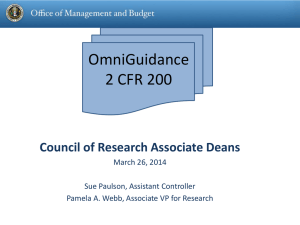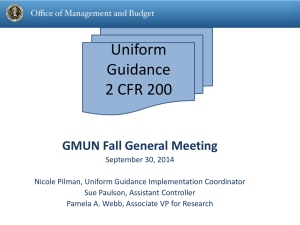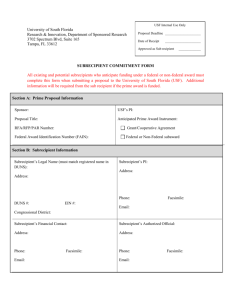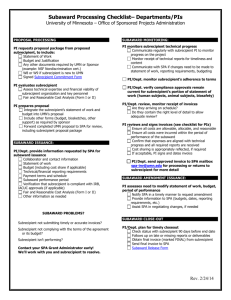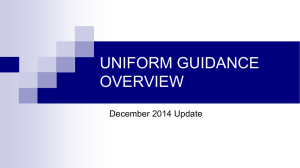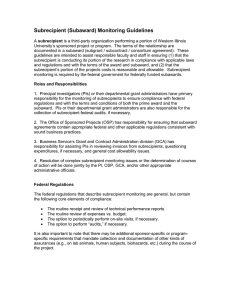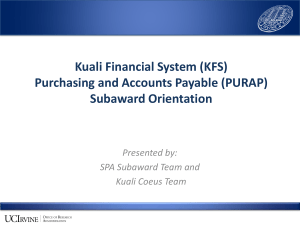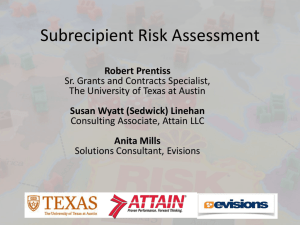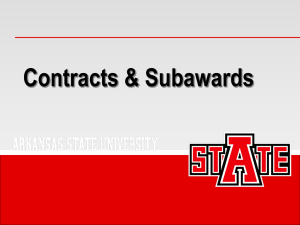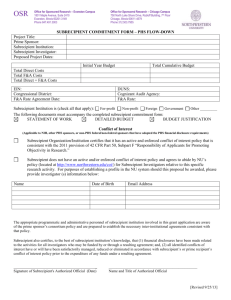Presentation to the Certified Approver Fall Users Group
advertisement
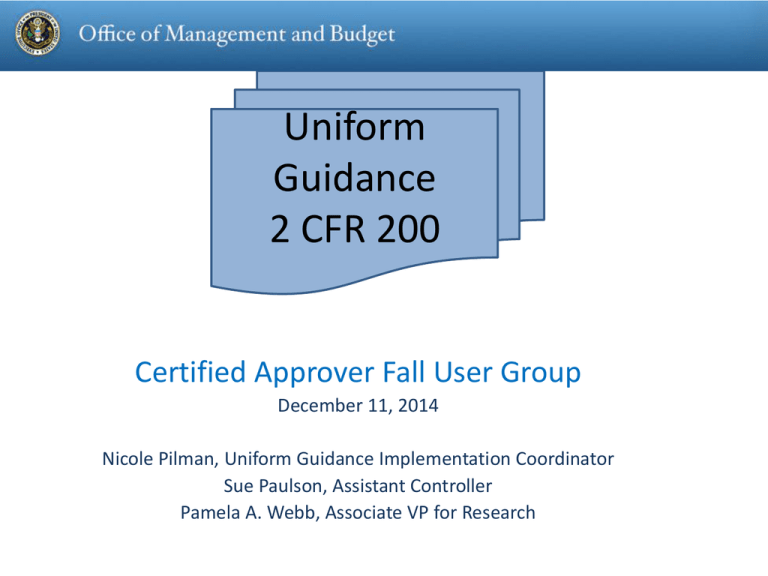
Uniform Guidance 2 CFR 200 Certified Approver Fall User Group December 11, 2014 Nicole Pilman, Uniform Guidance Implementation Coordinator Sue Paulson, Assistant Controller Pamela A. Webb, Associate VP for Research Goals of Updated Regulations METRICS METRICS Reduce fraud, waste, and abuse METRICS METRICS METRICS METRICS METRICS vs. METRICS METRICS METRICS OmniGuidance Implementation Plan 2013 2014 12/26/13 Release 6/26/14 Agency plans due to OMB Understand 2015 T o d a y 12/26/14 Implementation (all but audit) 2016 7/1/15 Audit provisions go into effect for UMN (OmniGuidance) Influence Plan (OmniGuidance) Understand (Agency) Plan (Agency) Implement Evaluate Refine On 12/26/14 • Uniform Guidance will apply to: – All New and Renewal awards issued (even if costed/budgeted and submitted under the old rules) • Old Rules (A-21, A-110, A-133) will apply to: – All active awards that do not get incremental funding or another award action (until they expire) • Uniform Guidance may apply to: – All non-competing awards (agencies may decide on a case-by-case basis) Uniform Guidance Org Chart Nicole Pilman, Uniform Guidance Implementation Coordinator (1 yr) Pamela Webb (Co-Chair) Suzanne Paulson (Co-Chair) Uniform Guidance Steering Committee COSTING Kevin McKoskey Seth Goldberg PROPERTY Jay Delaney Individual Specialists PRE-AWARD/ SUBAWARD Andrea Marshall Judy Krzyzek COI Work Lynn Zentner HR/EFFORT David Hagen Gayle Anderson PURCHASING Beth Tapp POST-AWARD Marjorie Nebo Jill Neu Before 12/26/14 • UG Steering Committee and Working Groups continue work on: – U-wide policy/procedure and training changes – Update Internal Business Processes – Monitor/update remaining pending issues • • • • SPA to update NOGA Terms and Conditions Federal agency implementation plans Federal “Research Terms and Conditions” replacement Prior Approvals matrix (contingent upon agency implementation plans and Research T&C) • Include new/modified items in proposals (PI Quick Guide) PI Quick Guide on Proposal Budgeting • Sent on 9/4/14 to: – All federal PIs and co-PIs (57% opened the email) – AEL list (63% opened) – All Certified Approvers – All Grants Management User Network Users – All SPA and SFR staff – Posted on SPA website – Referenced in UM Brief Please help by also distributing the information to your PIs! Charging Administrative/Clerical and Programmatic Salary Costs • Rules governing “major project or activity” exceptions have been dropped and replaced by the following criteria, all of which must be met: – Administrative or clerical services are integral to a project or activity; – Individuals involved can be specifically identified with the project or activity; – Such costs are explicitly included in the budget or have the prior written approval of the Federal awarding agency; and – The costs are not also recovered as indirect costs. • If all requirements are met, add a new justification statement to proposals to facilitate the required agency approval. Charging Administrative/Clerical and Programmatic Salary Costs cont. • After the award has been issued, seek agency approval through a letter prepared by the PI and countersigned by SPA if: – New or additional support is needed that is greater than 25% of approved effort at time of award (reductions are not subject to approval) • PIs should allow 30 days for this process – Therefore, no new or additional support can start until after agency approval is received. • If approved, SPA will revise the budget if a PeopleSoft friendly budget accompanies the letter request. – Otherwise, it is assumed that the Certified Approver will make the budgetary revision. Charging Administrative/Clerical and Programmatic Salary Costs cont. • Programmatic Costs… – may be direct charged using the same underlying requirements as other types of direct costs – are NOT subject to the extra approval requirements required of administrative and clerical costs • Examples of Programmatic Costs: – – – – protocol development and maintenance managing substances/chemicals managing and securing project-specific data coordination of research subjects Computing Devices (Under $5,000 Unit Cost) • Computing devices under $5,000/unit may be direct charged under the following circumstances: – The machines are essential* and allocable to the project – They are necessary to acquire, store, analyze, process, and publish data and other information electronically, • including accessories (or “peripherals”) for printing, transmitting and receiving, or storing electronic information – The project does not have reasonable access to other devices or equipment that can achieve the same purpose • devices may not be purchased for reasons of convenience or preference. • Items costing more than $5,000 per unit are considered equipment and follow federal equipment rules * PIs are responsible for determining whether or not the device is “essential” and to what extent the cost of the device is allocable to the sponsored project. PIs and departments should maintain documentation that describes how the proposed computing device meets the above requirements. Participant Support Costs • Participant support costs are not routinely allowed on research projects but can be charged with agency approval and the project includes: – An education or outreach component and the agency approves such costs. • Participant support costs may include: – Stipends or subsistence allowances – Travel allowances – Registration fees paid to or on behalf of participants or trainees (but not employees) in connection with conferences or training projects • These costs should be explicitly listed in the proposal budget or approved by the funding agency after the award has been made. Visa Costs • Since short-term visas are issued for a specific period of time and purpose, they can be direct charged to a Federal award if: – They can be clearly identified as directly connected to work performed on a Federal award – They are critical and necessary to the project and are allowable by the agency. • These visas allow employees and students to engage in field research or attend meetings in foreign locations, or allow foreign visitors to visit the University in support of the project. • Long-term visa costs, such as those that enable employment at the University (for example “J” and “H1B” visas) are not allowable as direct charges. F&A on Subawards • UMN and all of its subrecipients must use a federal program’s rate if it has a published statutory F&A cap. • For all other federal programs, the subrecipient’s federally negotiated F&A rate must be used if there is one. • If there is no negotiated F&A rate, a 10% de minimus F&A rate must be used, or the PI/department may request that SPA negotiate an F&A rate with the subrecipient. • Entities that have previously received negotiated rates with UMN are grandfathered in and UMN will continue to negotiate rates with these entities until they qualify to negotiate a rate directly with the federal government. • PIs may not negotiate or agree to lower rates with their subrecipients. • There is no change to UMN’s recovery of its own F&A – this remains limited to receiving our F&A on the first $25K of each subaward. F&A on Subawards cont. • SPA will, in rare circumstances, will negotiate a rate with a proposed subrecipient when the subrecipient: – Does not qualify to receive a rate directly from the federal government (currently, this means the entity does not receive direct federal funding of $750K or more per year) – Is expected to do at least $750,000 of business annually with UMN – There is reason to believe the F&A rate will be substantially higher than 10% MTDC. • If SPA agrees to negotiate a rate, 60 days advance notice (before the proposal is due to SPA) is required. Fixed Price/Rate Subawards • Agency prior approval is required to enter into a fixed price/rate subaward and the total value of each fixed price/rate subaward may not exceed $150K. • This will impact approximately 20% of all subawards issued by UMN, which are most commonly used for clinical trial site agreements, foreign subrecipients, and small businesses. • General research collaborations are not likely to be issued as fixed price. • To expedite agency approval, PIs/departments should add a new justification statement to proposals contemplating a fixed price/rate subaward. (A statement is not needed for other subawards.) Fixed Price/Rate Subawards cont. • Consult your SPA GA if: – If you are uncertain about how to set up the subaward at time of proposal – If you need multiple fixed price subawards to the same subrecipient to stay under the $150K threshold per subaward. • Other things to note: – You will be able to do an after-award-issuance request if it is determined that a fixed price subaward is needed, but not included in the proposal. – SPA reserves the right to make the final determination at time of subaward issuance whether to issue the subaward on a fixed price basis or cost-reimbursement basis. • This is true regardless of whether a fixed price justification statement was included in the proposal. After 12/26/14 • Upcoming issues of PI Quick Guide: – – – – Subawards (Winter 2015) Award Management (Spring 2015) Closeouts (Summer 2015) Procurement (Spring 2016) • DS-2 statement submitted to true-up charging practices to new rules (provides a safe harbor to universities during review by feds) • UMN’s upcoming F&A rate proposal (to be submitted Spring 2015 against a FY14 base year) • Single (A-133) Audit for UMN’s FY16 (July 2015 – June 2016) After 12/26/14 cont. • Implement new/revised processes for: – – – – – – Subrecipient Progress Reports Subrecipient Invoices Publication Costs 90 Day Enforced Closeouts Dependent Care while Traveling Procurement rules (effective 7/1/16) Subrecipient Progress Reports • Track and document review of subrecipient progress reports – Various options depending upon type of report (soft vs. hard copy): • Document review by email response, save email with report in local space • Save review notes, date and store with report in local space • Sign/initial document and store in local space • Submit to SPA • Upload to ImageNow Subrecipient Invoices • Payment of invoice from subrecipient within 30 days of receipt – Proposed process and considerations: • Create University email/drop box for submission of all subrecipient invoices • Ensure invoices route through U of M process within 30 days (PI approval) • How to manage situations where the invoice request seems improper • How to handle missing invoices Procurement • There are five procurement types and all must comply with the Procurement Standards which can be summarized as follows: 1. 2. 3. 4. 5. The purchase complies with the non-Federal entity’s documented procedures Purchases are necessary Open competition (to the extent required by each method) Conflict of interest policy Proper documentation for the purchases Procurement • How to follow new Procurement rules that will take effect one fiscal year after UG implementation (July 1, 2016)??? – UG states that for purchases between $3K and $150K, price or rate quotations must be obtained from an “adequate” number of qualified sources • “Relatively simple and informal” • UMarket & University-wide Contracts are already competitively bid and meet requirements • The logistics associated with “adequate” is to be determined by institutions Procurement FY14 Transaction data – Purchase Orders •Breakdown of Non-Sponsored/Sponsored Data •Purchase Order and UMarket transactions •Does not include Non-PO, Expense Reports or PCard transactions Up to $2,999 $3,000 to $9,999 $10,000 to $24,999 $25,000 to $49,999 $50,000 and over TOTAL TRANSACTION TYPE Non-Sponsored UMarket PO UMar PO UMarket PO UMarket PO UMarket PO UMarket PO 81,893 29,888 633 5,895 87 1,968 32 965 3 809 82,648 39,525 Sponsored 39,156 14,239 186 1,703 23 596 1 231 1 128 39,367 16,897 TOTAL 121,049 44,127 819 7,598 110 2,564 33 1,196 4 937 122,015 56,422 PCard Spend in FY14 Total Number of Transactions Total Dollars Number of Transactions between $2,500 and $49,999 Dollars for transactions between $2,500 and $49,999 Approximately 280,000 Approximately $64 million 642 $2,193,851 Publication Costs • Publication costs can be directed charged between award end date and date of final financial report – Must be charged to the project within 60 days after the award has ended (UMN determination) – Assumes there are unspent funds after the award has ended 90 Day Enforced Closeouts • Must submit, no later than 90 calendar days after the end date of the period of performance, all financial, performance, and other reports – Potentially will not be able to draw on expenses after 90 days – Need to understand financial & reputational risks • Expenses are still hitting the project after day 90 – most common are payroll & subrecipient invoices 90 Day Enforced Closeouts Expenses over 90 days old by RRC Acad Affairs&Provost, Sr VP AHC Shared Units Biological Sciences, Col of Carlson School of Management Dentistry, School Of Design, College of Education/Human Dev, Col of Equity & Diversity Food, Ag & Nat Res Sci, Col of Global Programs & Strategy Health Sciences Administration Information Technology, Ofc of Law School Liberal Arts, College of Medical School MN Extension Nursing, School of Pharmacy, College of Public Affairs, HHH School of Public Health, School of Science & Engineering, Col of Student Affairs, Vice Provost UM Crookston UM Duluth UM Morris Undergrad Ed, V Provost&Dean University Libraries Veterinary Medicine, Col of VP for Research, Office of Grand Total FY13 $ $ $ $ $ $ $ $ $ $ FY14 22,864.23 37,810.92 17,928.02 0.54 17,525.27 2,424.33 240,433.26 1,000.00 182,000.28 49,452.42 $ $ $ $ $ $ $ $ $ $ $ 242,876.86 16,425.58 4,966.04 1,539,765.37 8,005.35 13,567.72 15,461.46 24,037.03 1,406,356.65 760,316.07 15,951.32 $ $ $ $ $ $ $ 88,307.71 781.50 0.24 29,381.41 77,485.89 50,464.83 4,865,590.30 $ 203,099.09 $ 74,435.29 $ 47,952.22 $ 16,810.77 $ 2,425.32 $ 72,371.08 $ 122,766.65 $ 14,952.41 $ 0.06 $ 7,187.80 $ 12,706.28 $1,212,260.42 $ 1,717.38 $ 2,888.53 $ 3,940.17 $ 8,953.08 $ 311,748.53 $ 377,268.92 $ $ $ 0.10 27,097.51 10.51 $ 57,604.46 $ 15,438.32 $2,593,634.90 Grand Total $ 22,864.23 $ 240,910.01 $ 92,363.31 $ 47,952.76 $ 34,336.04 $ 4,849.65 $ 312,804.34 $ 1,000.00 $ 304,766.93 $ 64,404.83 $ 0.06 $ 250,064.66 $ 16,425.58 $ 17,672.32 $2,752,025.79 $ 9,722.73 $ 16,456.25 $ 19,401.63 $ 32,990.11 $1,718,105.18 $1,137,584.99 $ 15,951.32 $ 0.10 $ 115,405.22 $ 792.01 $ 0.24 $ 29,381.41 $ 135,090.35 $ 65,903.15 $7,459,225.20 % 0% 3% 1% 1% 0% 0% 4% 0% 4% 1% 0% 3% 0% 0% 37% 0% 0% 0% 0% 23% 15% 0% 0% 2% 0% 0% 0% 2% 1% 100% 90 Day Enforced Closeouts Expenses over 90 days FY13 FY14 Total All Sponsors $4,865,590.30 $2,593,634.90 $7,459,225.20 Federal Sponsors $1,798,944.90 $1,318,640.05 $3,117,584.95 % of Federal versus All Sponsors 36.97% 50.84% 41.80% Federal Agency Expenses over 90 days old by type of expense FY13 3,635.68 FY14 Total $ $ Capital Equipment $ 17,183.22 20,818.90 F&A $ 1,177,874.04 $ 313,566.10 $1,491,440.14 Non Salary $ 73,091.62 $ 132,742.26 $ 205,833.88 Salaries & Fringe $ 375,827.96 $ 371,080.46 $ 746,908.42 Subcontract payments $ 168,515.60 $ 484,068.01 $ 652,583.61 Grand Total $ 1,798,944.90 $1,318,640.05 $3,117,584.95 Questions??? • Additional information available at: – http://www.ospa.umn.edu/documents/UG.html
